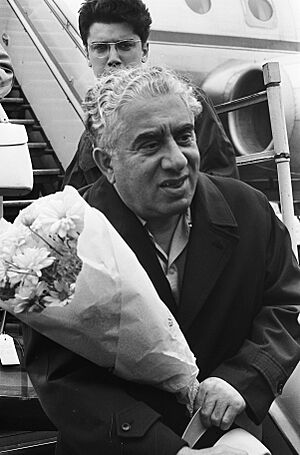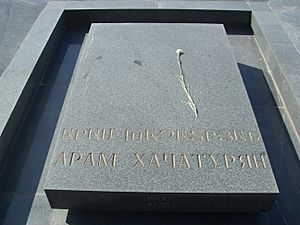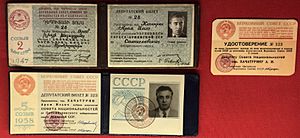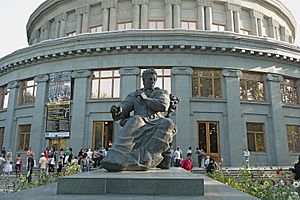Aram Khachaturian facts for kids
Quick facts for kids
Aram Khachaturian
|
|
|---|---|
| Арам Хачатурян Արամ Խաչատրյան |
|
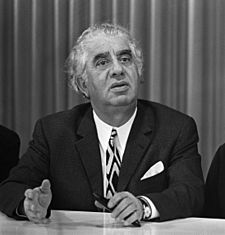
Khachaturian in 1971
|
|
| Born |
Aram Ilyich Khachaturian
6 June [O.S. 24 May] 1903 Tiflis, Tiflis Governorate, Russian Empire
|
| Died | 1 May 1978 (aged 74) Moscow, Soviet Union
|
| Burial place | Komitas Pantheon, Yerevan, Armenia |
| Alma mater | Gnessin Musical Institute, Moscow Conservatory |
| Years active | 1926–1978 |
| Era | 20th-century classical music |
| Political party | Communist Party of the Soviet Union (from 1943) |
| Spouse(s) |
Nina Makarova
(m. 1933; died 1976) |
| Children | 2 |
| Awards | Full list |
| Signature | |
Aram Ilyich Khachaturian (born June 6, 1903 – died May 1, 1978) was a famous Armenian composer and conductor. He is known as one of the most important composers from the Soviet Union.
Khachaturian was born and grew up in Tbilisi, which is the capital of Georgia. This city was a mix of many cultures. In 1921, he moved to Moscow. Even though he had no music training before, he started studying music at the Gnessin Musical Institute. Later, he went to the Moscow Conservatory.
His first big success was the Piano Concerto in 1936. This made him famous both inside and outside the Soviet Union. He also wrote the Violin Concerto (1940) and the Cello Concerto (1946). Other well-known works include the Masquerade Suite (1941) and the Anthem of the Armenian SSR (1944). He also composed three symphonies and about 25 film scores.
Khachaturian is most famous for his ballet music. These include Gayane (1942) and Spartacus (1954). His most popular piece is the "Sabre Dance" from Gayane. This song has been used a lot in movies and TV shows around the world. His music is known for its bright sounds, catchy rhythms, and beautiful melodies.
For most of his career, Khachaturian was supported by the Soviet government. He held important jobs in the Union of Soviet Composers. In 1948, he was criticized by the government for his music style, but he was soon accepted again. After 1950, he taught at the Gnessin Institute and the Moscow Conservatory. He also started conducting his own music in many countries.
Khachaturian created the first Armenian ballet music, symphony, concerto, and film score. He is seen as the most famous Armenian composer of the 20th century. He used a lot of Armenian folk music in his works. He also used sounds from other Caucasian, Eastern, and Middle Eastern cultures. In Armenia, he is considered a "national treasure."
Contents
Biography
Early Life (1903–1921)
Aram Khachaturian was born on June 6, 1903. He was born in Tiflis, which is now called Tbilisi, in Georgia. His family was Armenian. Some say he was born in a village called Kojori, near Tiflis. Khachaturian himself said he was born there.
His father, Yeghia, owned a bookbinding shop. His mother, Kumash, was also from a village near Ordubad. Aram was the youngest of their five children. He went to a school for merchants in Tiflis. At first, he thought about becoming a doctor or an engineer.
Tiflis was a very important city in the Caucasus region. It was a place where many different cultures met. Khachaturian grew up hearing many kinds of music and languages. The city had a large Armenian community and was a big center for Armenian culture.
Education (1922–1936)
In 1921, when he was 18, Khachaturian moved to Moscow. He joined his older brother, Suren, who worked at the Moscow Art Theatre. In 1922, Aram started at the Gnessin State Musical College. He also studied biology at Moscow State University at the same time.
He first learned to play the cello. In 1925, he joined a class for composing music. During this time, he wrote his first pieces. These included the Dance Suite for violin and piano (1926). From his very first works, Khachaturian used a lot of Armenian folk music.
In 1929, Khachaturian went to the Moscow Conservatory. He studied composing with Nikolai Myaskovsky. He finished his studies there in 1934.
Early Career and Success (1936–1948)
Khachaturian's First Symphony was his graduation project in 1935. It was inspired by Armenian music. Famous conductors noticed it, and it was played by top Soviet orchestras. This work was even admired by another great composer, Shostakovich.
He started his full-time composing career in 1936. That year, he wrote his first major work, the Piano Concerto. It was a big hit and made him a respected composer in the Soviet Union. This piece also made his name known far beyond the Soviet borders.
His Piano Concerto, along with his later Violin Concerto (1940) and Cello Concerto (1946), are seen as a group of important works. The Violin Concerto became famous worldwide. It was first played by the well-known violinist David Oistrakh.
Khachaturian held important positions in the Union of Soviet Composers. He became a deputy chairman in 1937. He joined the Communist Party in 1943. He used his position to help shape Soviet music. He wanted music to be both skillful and easy to understand.
The years around World War II were very busy for Khachaturian. In 1939, he spent six months in Armenia. He wanted to study Armenian folk music and collect songs and dances. He said this trip was like a "second conservatory" for him. It helped him understand the tastes of the Armenian people.
In 1942, during World War II, he turned his first ballet, Happiness, into Gayane. It was first performed in Perm while Leningrad was under attack. It was a huge success. Khachaturian even gave his prize money back to the state to help build a tank for the army.
He wrote his Second Symphony in 1943. He also composed music for the play Masquerade (1944). Both Gayane and the Second Symphony were very popular. In 1944, he wrote the Anthem of the Armenian Soviet Socialist Republic.
Challenges and Comeback (1948)
In 1948, Khachaturian and other leading composers faced criticism from the Communist Party. Their music was called "anti-people" and too difficult for ordinary people to enjoy. This was part of a movement against "formalism" in art. Khachaturian's Third Symphony (1947) was especially criticized. He had actually written it to celebrate the 30th anniversary of the October Revolution. He wanted it to show the Soviet people's joy in their country.
Some experts believe Khachaturian was criticized more because of his important role in the Composers' Union. They thought the Union was supporting music that the government didn't like. In March 1948, Khachaturian apologized for his "mistakes." However, his musical style did not really change. He was sent to Armenia for a while as a "punishment."
By December 1948, he was back in favor. He received praise for his music for the film Vladimir Ilyich Lenin.
Later Life (1950–1978)
In 1950, Khachaturian started conducting his own music. He also began teaching composition at the Gnessin Institute and the Moscow Conservatory. He taught his students that folk music was very important. He believed composers should learn about their nation's folk music.
From 1950 to 1954, he worked on his last ballet, Spartacus. This became his most famous work after the Stalin era. He updated Spartacus in 1968. In 1954, he was named People's Artist of the Soviet Union.
After Spartacus, Khachaturian composed less. He focused more on conducting, teaching, and traveling. He visited about 30 countries, including Europe, Latin America, and the United States. He conducted concerts of his own music.
From 1957 until his death, Khachaturian served as Secretary of the Composers Union. In his last 20 years, he wrote three concert rhapsodies for violin, cello, and piano. He also wrote solo sonatas for cello, violin, and viola.
Music
Khachaturian's music includes ballets, symphonies, concertos, and film scores. Music critic Edward Greenfield said that Khachaturian created a unique style. It was a style that other Soviet composers found hard to copy. He wrote many of his famous works between 1936 and 1946. Even after the criticism in 1948, he only created one more internationally famous work, the ballet Spartacus.
What made Khachaturian special was how he mixed Armenian folk music with modern orchestra techniques. His music often has strong rhythms. These rhythms can be repeated or have playful changes.
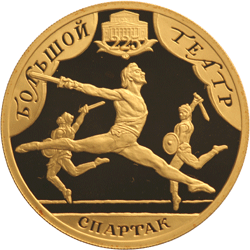
Works
Ballet
Khachaturian is best known for his ballet music. His second ballet, Gayane, was a new version of his first ballet, Happiness. It is a very popular ballet in Soviet and Eastern European dance. Spartacus became his most famous work after the Stalin era. These two ballets are his most successful compositions. Many people around the world know Armenian music mostly through these two ballets.
Spartacus became even more popular when its "Adagio of Spartacus and Phrygia" was used as the theme for the BBC TV show The Onedin Line in the 1970s. Parts of Spartacus were also used in movies like Caligula (1979) and Ice Age: The Meltdown (2006). The movie The Hudsucker Proxy (1994) also used music from Spartacus and Gayane, including the "Sabre Dance." The "Adagio" from Gayane was used in Stanley Kubrick's famous film 2001: A Space Odyssey.
Orchestral Music
Khachaturian wrote three symphonies. The First was in 1934/5, the Second in 1943, and the Third in 1947. He also wrote three concertos: the Piano Concerto (1936), the Violin Concerto (1940), and the Cello Concerto (1946).
Other Compositions
Khachaturian wrote music for several plays. These include Macbeth (1934, 1955) and King Lear (1958).
He was the first Soviet composer to write music for sound films. He created about 25 film scores. One of them was for Pepo (1935), the first Armenian sound film. In 1950, he won a Stalin Prize for his music for the film The Battle of Stalingrad (1949).
Influences
Music expert Marina Frolova-Walker said Khachaturian was the only famous Soviet composer who came from a "nationalist" music background. Khachaturian believed that music is a language created by people. He thought that folk music shows the national spirit of an artwork.
Composer Tigran Mansurian suggested that Khachaturian's music has American qualities. He called the United States his "second homeland" for musical influences. This was especially true for the hopeful feeling in his works.
Armenian Folk Music
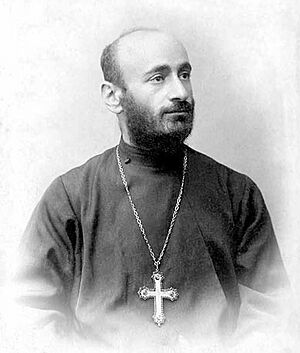
Khachaturian is well known for using folk songs from different groups in his music. He especially used Armenian folk songs. Many of his pieces sound like Armenian melodies. However, his works were different from typical folk music arrangements. He mixed the lively rhythms of Caucasian dance music with European musical styles. This created a unique sound.
Khachaturian was greatly influenced by Komitas. Komitas was a musician who collected Armenian folk songs. Khachaturian said that Komitas "singlehandedly laid the foundations for Armenia's classical tradition." He called Komitas his "greatest teacher."
Khachaturian always emphasized his Armenian background. He said that his music was always connected to his homeland.
Other Folk Music
When he was a student, Khachaturian wrote down Armenian, Russian, Hungarian, and Turkish folk songs. In his later works, he used elements from folk songs of Caucasian (like Georgians), Eastern European (like Ukrainians and Poles), and Middle Eastern (like Turks and Kurds) peoples.
His first ballet, Happiness, included a Ukrainian gopak. It also had Georgian, Armenian, and Russian dances, and a Lezginka. The Masquerade Suite has a Mazurka, a Polish folk dance. The ballet Gayane also features a Lezginka. Part of Gayane is filled with Kurdish dances.
Russian Classical Music
Khachaturian is also seen as a follower of Russian classical music traditions. He continued the colorful, folk-inspired style of 19th-century Russian composers. These included Rimsky-Korsakov and Tchaikovsky. Like some of these composers, Khachaturian used "Eastern" sounds in his works.
His strong musical training in the Soviet system helped him use Eastern and Caucasian music deeply. He blended it fully into his later works, especially his ballets. He always stayed connected to Russian music traditions. He was seen as a voice for the entire Soviet East, bringing many different traditions together.
Khachaturian's Influence
Khachaturian taught many students at the Gnessin Institute and the Moscow Conservatory. His students came from different countries, like Egypt, Venezuela, and Romania. He also taught many Soviet composers.
He inspired young Armenian composers. He had a big impact on how Armenian music developed. His influence can be seen in the chamber and symphonic music of Armenia.
Khachaturian also influenced composers in Azerbaijan, Central Asia, and East Asia. The music of Japanese composer Roh Ogura was influenced by Khachaturian's rhythms. Some Chinese composers trained in the Soviet Union were also influenced by him. For example, the Chinese ballet Red Detachment of Women sounds similar to Khachaturian's ballets like Spartacus.
Personal Life
In 1933, Khachaturian married composer Nina Makarova. She was also a student in his class at the Moscow Conservatory. Nina was known as a popular Soviet woman composer. She said that Aram was "Armenian — temperamental, strong and a bit Oriental." She described herself as "Russian and lyric."
They had two children, a daughter named Nune and a son named Karen. Nune became a pianist, and Karen became an art critic. His nephew, Karen Khachaturian, was also a composer.
In October 1965, Khachaturian had a heart attack and was in a hospital. He passed away in Moscow on May 1, 1978. He was almost 75 years old. He was buried at the Komitas Pantheon in Yerevan on May 6. This is a special place where many famous Armenians are buried.
People who knew Khachaturian described him in different ways. Music critic Harriett Johnson called him "sturdy, stocky and youthful." Composer Dmitri Shostakovich said that meeting Khachaturian meant having a good meal and chatting. He described Khachaturian as having a "basically optimistic, life-asserting view." However, German conductor Kurt Masur said Khachaturian could be "sometimes an uncomfortable person."
Views
Khachaturian was very enthusiastic about communism. He believed it changed his life for the better. He said that if he became a serious artist, it was thanks to the Soviet people and government. He dedicated his life and work to them.
Khachaturian said that his music was not censored in the Soviet Union. When asked about the criticisms in 1948, he said his music was just "too loud." He believed a composer should stick to their own ideas.
Recognition and Reputation
Khachaturian is generally seen as one of the most important composers of the Soviet Union. He is often mentioned with Dmitri Shostakovich and Sergei Prokofiev as one of the three greatest Soviet-era composers.
The Los Angeles Philharmonic says his works are not as famous worldwide as those of Shostakovich and Prokofiev. However, he was one of the few Soviet composers known to a wider international audience. He was seen as a symbol of the Soviet idea of different cultures coming together in art. Unlike Prokofiev and Shostakovich, Khachaturian's career grew entirely within the Soviet music system.
Reputation in the West
Some people in the West have seen Khachaturian as a "lighter-weight" composer. However, classic music broadcaster Norman Gilliland calls him a "major" composer of the 20th century. Music critic Harold C. Schonberg was often critical of Khachaturian. He wrote that Khachaturian was a "minor figure" and that his music was "formula writing."
In 1968, music critic Harriett Johnson praised Khachaturian. She liked his unique melodies with their "Oriental flavor" from his Armenian background. She also liked the strong rhythm in his music. She called him a "immense musician." In 2009, Tim Ashley wrote that Khachaturian's popularity in the West dropped. This was because he was seen as someone who always agreed with the Soviet government. But Ashley noted that Khachaturian did have problems with the authorities in 1948. Conductor Marin Alsop said in 2003 that Khachaturian is "very underperformed" and "somewhat underrated."
In Armenia
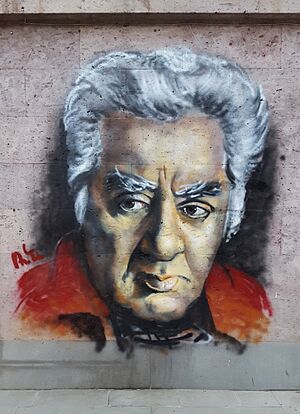
Khachaturian was the most famous Armenian composer of the 20th century. He was also the most well-known person in Soviet Armenian culture. He is called "by far the most important Armenian composer." He is also known as the "Armenian Tchaikovsky." He is a key figure in Armenian culture of the 20th century. He is the only Armenian composer to become famous worldwide. Khachaturian is praised for bringing Armenian music to global attention. He has been called the "musical ambassador of Armenian culture."
Khachaturian is one of the "modern icons of Armenian pride." He is considered a national treasure. Armenians celebrate him as a famous son who gained worldwide recognition.
Posthumous Honors and Tribute
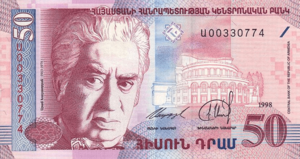
The philharmonic hall of the Yerevan Opera Theater has been called the Aram Khachaturian Grand Concert Hall since 1978. The House-Museum of Aram Khachaturian in Yerevan opened in 1982.
In 1998, the Central Bank of Armenia put Khachaturian's picture on the 50-dram banknote. It also showed the Yerevan Opera Theater. The back of the note showed a scene from the ballet Gayane and Mount Ararat. This banknote was used until 2004. He is one of only two composers on Armenian money.
In 2013, UNESCO added a collection of Khachaturian's notes and film music to its Memory of the World Register.
Music schools are named after Khachaturian in Tbilisi, Moscow, Yerevan, and other places. Streets in Yerevan, Tbilisi, and Moscow are also named after him.
In 1993, a music festival called Aram Khachaturian-93 was held in Yerevan. The Aram Khachaturian International Competition is held every year in Yerevan since 2003.
Statues
On July 31, 1999, a statue of Khachaturian was unveiled in front of the Khachaturian Hall of the Yerevan Opera Theater. It was made by Yuri Petrosyan.
On April 30, 2013, a bust (a statue of his head and shoulders) of Khachaturian was placed on the street named after him in Yerevan.
A statue of Khachaturian by Georgiy Frangulyan was unveiled in Moscow on October 31, 2006. Busts of Khachaturian were also put up at the Moscow Conservatory in 2017 and in Nizhny Novgorod in 2021.
Films
In 1977, a year before he passed away, Studio Ekran made a documentary about Khachaturian. In 1983, the Yerevan Studio made another TV documentary about him. In 2003, an 83-minute documentary about Khachaturian was made by Peter Rosen. It won the Best Documentary award at the 2003 Hollywood Film Festival. In 2004, a Russian TV channel made a documentary called Century of Aram Khachaturian.
Awards and Honors
Soviet Union
- Hero of Socialist Labour (1973)
- Order of Lenin (1939, 1963, 1973)
- People's Artist of the USSR (1954), Russian SFSR (1947), Armenian SSR (1955), Georgian SSR (1963), Azerbaijan SSR (1973)
- Honored Art Worker of the Armenian SSR (1938), Russian SFSR (1944), Uzbek SSR (1967)
- Order of the Red Banner of Labour (1945, 1966)
- Order of the October Revolution (1971)
- Lenin Prize (1959) for the ballet Spartacus
- Stalin Prize (1941 for Violin Concerto, 1943 for ballet Gayane, 1946 for the Second Symphony, 1950 for the film The Battle of Stalingrad
- USSR State Prize (1971 for the Triad of Concerto-Rhapsodies: for violin and orchestra; for cello and orchestra; for piano and orchestra)
Other States
- Order of the Science of Art of the United Arab Republic (1961, "for outstanding musical achievements")
- Medal of Pope John XXIII (1963)
- Medal of the Iranian Shah (1965)
- Honored Art Worker of Polish People's Republic (1972, "for contribution to the Polish culture")
- Ordre des Arts et des Lettres (France) and title of Commandeur (1974)
Academic Titles
- Professor of Music — 1950
- Honorary Member of the Accademia Nazionale di Santa Cecilia, Rome, Italy — 1960
- Corresponding Member of the Academy of Arts of the German Democratic Republic — 1961
- Honorary Professor of the Conservatorio Nacional de Música, Mexico — 1960
- Full Member (Academician) of the Academy of Sciences of the Armenian SSR — 1963
- Doctor of Arts (Доктор искусствоведения), Academy of Sciences of the USSR — 1965
See also
 In Spanish: Aram Jachaturián para niños
In Spanish: Aram Jachaturián para niños
Images for kids


